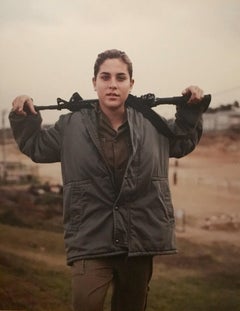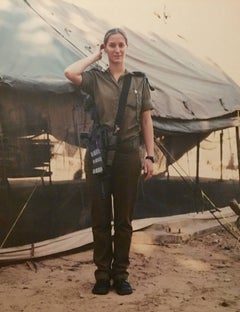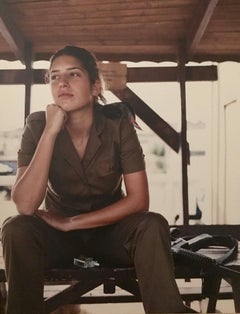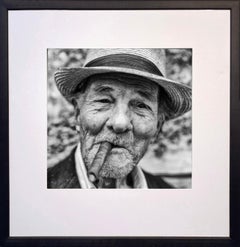Ashkan Sahihi Art
to
3
Overall Width
to
Overall Height
to
3
3
3
3
1
3
9,514
2,710
1,375
1,361
3
Artist: Ashkan Sahihi
WOMEN OF THE IDF Large color Photograph LITAL
By Ashkan Sahihi
Located in Surfside, FL
"Women of the IDF" Large Exhibition color Photograph
30 x 40 inches, mounted on masonite and laminated.
Edition of 4 + 2 artists proof. minor dings and bumps to edges Born in Teh...
Category
Early 2000s Ashkan Sahihi Art
Materials
Masonite
WOMEN OF THE ISRAEL DEFENSE FORCES Large Photo NETA
By Ashkan Sahihi
Located in Surfside, FL
"Women of the IDF" Large Exhibition color Photograph
30 x 40 inches, mounted on masonite and laminated.
Edition of 4 + 2 artists proof. minor dings and bumps to edges Born in Teh...
Category
Early 2000s Ashkan Sahihi Art
Materials
Masonite
Large Color Photograph "Women of the IDF" Ashkan Sahihi
By Ashkan Sahihi
Located in Surfside, FL
"Women of the IDF" Large Exhibition color Photograph
30 x 40 inches, mounted on masonite and laminated.
Edition of 4 + 2 artists proof. minor dings and bumps to edges Born in Tehra...
Category
Early 2000s Ashkan Sahihi Art
Materials
Laminate, Masonite
Related Items
Kate Moss 1993, Paradise Island Bahamas, Original C-type Print, Custom Framed
By Herb Ritts
Located in London, GB
For the 1994 Pirelli Calendar shot on the Paradise Island in the Bahamas, photographer Herb Ritts set out to capture in a series of nudes what he called “the gentle innocence” of Kat...
Category
1990s Contemporary Ashkan Sahihi Art
Materials
Archival Paper, C Print, Photographic Paper, Photographic Film, Wood, Glass
$4,238 Sale Price
20% Off
H 15.75 in W 10.63 in D 1.58 in
El Caballero - Framed portrait of an old cigar-smoking Cuban man with a smile
By James Sparshatt
Located in Coltishall, GB
The gentleman… a man of calm dignity and endessly kind eyes in Old Havana in 2016.
The Spirit of the Revolution series documents the generation of Cubans that saw the dramatic chan...
Category
21st Century and Contemporary Naturalistic Ashkan Sahihi Art
Materials
Glass, Wood, Silver Gelatin
$1,542
H 22.84 in W 22.45 in D 0.4 in
The Swan, With Leda (Limited Edition of 25) - 30x40 In Fine Art Print
Located in New York, NY
This 2009 photograph by legend photographer, John Stoddart depicts “The Swan with Leda.” It was inspired from the mythology of the Greek story of Leda and the Swan, when the God Zeus...
Category
Early 2000s Conceptual Ashkan Sahihi Art
Materials
Silver Gelatin
The Swan, With Leda (Limited Edition of 25)
Located in New York, NY
This 2009 photograph by legend photographer, John Stoddart depicts “The Swan with Leda.” It was inspired from the mythology of the Greek story of Leda and the Swan, when the God Zeus...
Category
Early 2000s Conceptual Ashkan Sahihi Art
Materials
Silver Gelatin
Tilda Swinton (Limited Edition of 25) - Celebrity Photography
Located in New York, NY
This 1986 black and white photograph was shot by British celebrity and fashion photographer, John Stoddart, captures Oscar-winning actress Tilda Swinton,...
Category
1980s Young British Artists (YBA) Ashkan Sahihi Art
Materials
Silver Gelatin
$2,682
H 24 in W 20 in
Captain Nelson (29 Palms, CA) - Contemporary, Polaroid, 21st Century, Dream
By Stefanie Schneider
Located in Morongo Valley, CA
Captain Nelson (29 Palms, CA) - 2007
37x49x3.5cm,
Edition 1/5.
Artist Inventory No 4033.01.
Analog C-Print, Hand-printed by the artist, mounted on a wooden box with matte UV-Prot...
Category
Early 2000s Contemporary Ashkan Sahihi Art
Materials
Wood, Archival Paper, Photographic Paper, C Print, Color, Polaroid
$3,200
H 14.57 in W 19.3 in D 1.38 in
Fashion by John Galliano, his First Collection, London (Limited Edition of 25)
Located in New York, NY
This 1987 print features an iconic fashion shot captured by legend photographer, John Stoddart, from John Galliano’s (then, Britain’s most famous fashion stylist) first ever collecti...
Category
1980s Contemporary Ashkan Sahihi Art
Materials
Archival Paper
Tilda Swinton (Limited Edition of 25), 30x40 In - Celebrity Photography
Located in New York, NY
This 1986 black and white photograph was shot by British celebrity and fashion photographer, John Stoddart, captures Oscar-winning actress Tilda Swinton,...
Category
1980s Young British Artists (YBA) Ashkan Sahihi Art
Materials
Silver Gelatin
$6,438 Sale Price
20% Off
H 40 in W 30 in
Nan Goldin Supreme set of 2 skateboard decks (Nan Goldin Supreme)
By Nan Goldin
Located in NEW YORK, NY
Nan Goldin Supreme Skateboard Decks, 2018 (set of 2):
– Misty and Jimmy Paulette in a taxi, (NYC 1991)
– Nan as a Dominatrix (Cambridge MA 1978)
Set of 2 limited edition Nan Goldin ...
Category
21st Century and Contemporary Street Art Ashkan Sahihi Art
Materials
Wood, Offset
D. and Felix - Contemporary, 21st Century, Polaroid, Figurative Photography
By Stefanie Schneider
Located in Morongo Valley, CA
D. and Felix (Stranger than Paradise) - 1997
Edition of 2/30.
Image size 16 x 21.6 inch,
External dimensions: 17.7 x 23.3 inch.
Archival C-Print, based on the Polaroid.
Mounted...
Category
1990s Contemporary Ashkan Sahihi Art
Materials
Wood, Archival Paper, Photographic Paper, C Print, Polaroid
$1,200
H 23.3 in W 17.7 in D 1 in
IGGY POP - FROM THE ALBUM COVER SOLDIER 1980, STUDIO PORTRAIT (1979)
Located in London, GB
IGGY POP - FROM THE ALBUM COVER SOLDIER 1980, STUDIO PORTRAIT (1979), 1979
Archival Pigment Print, Framed
Image size 30 x 30 cm
Frame: 55 x 45.5 cm
© Brian Griffin
"I remember this...
Category
1970s Surrealist Ashkan Sahihi Art
Materials
Wood, Glass, Photographic Film, Photographic Paper, Color, Archival Pigment
$3,051 Sale Price
35% Off
H 21.66 in W 17.92 in D 1.58 in
Chefs's Last Supper - Portrait of 13 Michelin-starred Chefs - Framed Print
Located in London, GB
'Last supper' of 13 Michelin-starred Chefs...
John Reardon is particularly associated with his portraits of chefs for the Observer Food Monthly (UK) for which this commission based o...
Category
Early 2000s Contemporary Ashkan Sahihi Art
Materials
Glass, Wood, Photographic Film, Archival Ink, Archival Paper, Photograph...
$9,054 Sale Price
25% Off
H 81 in W 127 in D 4 in
Previously Available Items
WOMEN OF THE ISRAEL DEFENSE FORCES Large Photo NETA
By Ashkan Sahihi
Located in Surfside, FL
"Women of the IDF" Large Exhibition color Photograph
30 x 40 inches, mounted on masonite and laminated.
Edition of 4 + 2 artists proof. minor dings and bumps to edges Born in Tehran, Iran, Ashkan Sahihi moved with his family to West Germany at the age of seven. Although he began taking photographs as a teenager, Sahihi traces the beginning of his professional trajectory to New York in 1987, a thriving “pop culture metropolis” where he could do the kind of photography work that he wanted to do, exploring the underbelly of the society around him. Taking assignments from German publications such as the Süddeutsche Zeitung Magazine, Der Spiegel, Dummy and GEO, he photographed subjects like prisoners on death row, players in the hip-hop scene, and the downtown art scene of New York. Neither black nor white, an insider among outsiders, he found himself able to navigate spaces and dynamics that others might have had difficulty entering. He considered this both a privilege and an obligation – to visit these places and tell these stories. His success led to commissions from American publications as well, including the New York Times Magazine, the New Yorker, Rolling Stone, and Vogue.
Put off by the limitations of photojournalism (the expectation that he would illustrate the writer’s perspective rather than author a narrative of his own), Sahihi began to embark on independent, highly compact conceptual series. His main goal in these series has been to drive forward public discourse on topics he believes have not provoked enough or the right kind of discussion: drugs, gender in the media, women in the military, etc. His portraits draw on a familiar visual language – often seated subjects before a neutral backdrop – but push the viewer to feel and think about entirely new things. Although he constantly challenges the comfort level of both the viewer and the subject, Sahihi never removes himself from the line of fire; all of his work requires the artist to immerse himself in uncomfortable situations and challenge his own emotional fortitude.
Photographic Series
In the “Face Series”, latex-gloved hands manipulate the subjects’ features, stretching, pushing, squeezing, pinching at the whim of external direction – from the artist? The customer? The public? The “Hypnosis Series” comprises 8 portraits of hypnotized subjects each experiencing a single emotion, e.g. helplessness, withholding/anger, or regret. In a society that rewards the suppression of such naked emotion, the purity of these depictions is arresting.
In 2006, Sahihi photographed himself in the homes and with the families of six ex-girlfriends and one ex-wife, imposing himself more or less awkwardly on the constellations that emerged after he had exited their lives (“Exes Series”).
For Sahihi’s most well-known work, the “Drug Series,” he convinced 11 non–drug users to consume a particular drug, then took their portraits over the course of their trips. The series was born out of Sahihi’s frustration with the hypocrisy of the political conversation about drugs in the United States. “By attempting to present an objective image of drug use, the artist addresses the cultural politics that allow our society to simultaneously glamorize the ‘drug look’ in fashion magazines and the entertainment industry and meanwhile turn a blind eye to the complicated, and vast, problem of drug abuse.” Sahihi has exhibited this series at MoMA PS1 New York in 2001, in Dresden in 2008, and alongside his installation “100 Million in Ready Cash."
Sahihi’s dense explorations through small photographic series include “Women of the IDF," portraits of female Israeli soldiers...
Category
Early 2000s Ashkan Sahihi Art
Materials
Masonite
WOMEN OF THE IDF Large color Photograph LITAL
By Ashkan Sahihi
Located in Surfside, FL
"Women of the IDF" Large Exhibition color Photograph
30 x 40 inches, mounted on masonite and laminated.
Edition of 4 + 2 artists proof. minor dings and bumps to edges Born in Tehran, Iran, Ashkan Sahihi moved with his family to West Germany at the age of seven. Although he began taking photographs as a teenager, Sahihi traces the beginning of his professional trajectory to New York in 1987, a thriving “pop culture metropolis” where he could do the kind of photography work that he wanted to do, exploring the underbelly of the society around him. Taking assignments from German publications such as the Süddeutsche Zeitung Magazine, Der Spiegel, Dummy and GEO, he photographed subjects like prisoners on death row, players in the hip-hop scene, and the downtown art scene of New York. Neither black nor white, an insider among outsiders, he found himself able to navigate spaces and dynamics that others might have had difficulty entering. He considered this both a privilege and an obligation – to visit these places and tell these stories. His success led to commissions from American publications as well, including the New York Times Magazine, the New Yorker, Rolling Stone, and Vogue.
Put off by the limitations of photojournalism (the expectation that he would illustrate the writer’s perspective rather than author a narrative of his own), Sahihi began to embark on independent, highly compact conceptual series. His main goal in these series has been to drive forward public discourse on topics he believes have not provoked enough or the right kind of discussion: drugs, gender in the media, women in the military, etc. His portraits draw on a familiar visual language – often seated subjects before a neutral backdrop – but push the viewer to feel and think about entirely new things. Although he constantly challenges the comfort level of both the viewer and the subject, Sahihi never removes himself from the line of fire; all of his work requires the artist to immerse himself in uncomfortable situations and challenge his own emotional fortitude.
Photographic Series
In the “Face Series”, latex-gloved hands manipulate the subjects’ features, stretching, pushing, squeezing, pinching at the whim of external direction – from the artist? The customer? The public? The “Hypnosis Series” comprises 8 portraits of hypnotized subjects each experiencing a single emotion, e.g. helplessness, withholding/anger, or regret. In a society that rewards the suppression of such naked emotion, the purity of these depictions is arresting.
In 2006, Sahihi photographed himself in the homes and with the families of six ex-girlfriends and one ex-wife, imposing himself more or less awkwardly on the constellations that emerged after he had exited their lives (“Exes Series”).
For Sahihi’s most well-known work, the “Drug Series,” he convinced 11 non–drug users to consume a particular drug, then took their portraits over the course of their trips. The series was born out of Sahihi’s frustration with the hypocrisy of the political conversation about drugs in the United States. “By attempting to present an objective image of drug use, the artist addresses the cultural politics that allow our society to simultaneously glamorize the ‘drug look’ in fashion magazines and the entertainment industry and meanwhile turn a blind eye to the complicated, and vast, problem of drug abuse.” Sahihi has exhibited this series at MoMA PS1 New York in 2001, in Dresden in 2008, and alongside his installation “100 Million in Ready Cash."
Sahihi’s dense explorations through small photographic series include “Women of the IDF," portraits of female Israeli soldiers...
Category
Early 2000s Ashkan Sahihi Art
Materials
Masonite
Large Color Photograph "Women of the IDF" Ashkan Sahihi
By Ashkan Sahihi
Located in Surfside, FL
"Women of the IDF" Large Exhibition color Photograph
30 x 40 inches, mounted on masonite and laminated.
Edition of 4 + 2 artists proof. minor dings and bumps to edges Born in Tehran, Iran, Ashkan Sahihi moved with his family to West Germany at the age of seven. Although he began taking photographs as a teenager, Sahihi traces the beginning of his professional trajectory to New York in 1987, a thriving “pop culture metropolis” where he could do the kind of photography work that he wanted to do, exploring the underbelly of the society around him. Taking assignments from German publications such as the Süddeutsche Zeitung Magazine, Der Spiegel, Dummy and GEO, he photographed subjects like prisoners on death row, players in the hip-hop scene, and the downtown art scene of New York. Neither black nor white, an insider among outsiders, he found himself able to navigate spaces and dynamics that others might have had difficulty entering. He considered this both a privilege and an obligation – to visit these places and tell these stories. His success led to commissions from American publications as well, including the New York Times Magazine, the New Yorker, Rolling Stone, and Vogue.
Put off by the limitations of photojournalism (the expectation that he would illustrate the writer’s perspective rather than author a narrative of his own), Sahihi began to embark on independent, highly compact conceptual series. His main goal in these series has been to drive forward public discourse on topics he believes have not provoked enough or the right kind of discussion: drugs, gender in the media, women in the military, etc. His portraits draw on a familiar visual language – often seated subjects before a neutral backdrop – but push the viewer to feel and think about entirely new things. Although he constantly challenges the comfort level of both the viewer and the subject, Sahihi never removes himself from the line of fire; all of his work requires the artist to immerse himself in uncomfortable situations and challenge his own emotional fortitude.
Photographic Series
In the “Face Series”, latex-gloved hands manipulate the subjects’ features, stretching, pushing, squeezing, pinching at the whim of external direction – from the artist? The customer? The public? The “Hypnosis Series” comprises 8 portraits of hypnotized subjects each experiencing a single emotion, e.g. helplessness, withholding/anger, or regret. In a society that rewards the suppression of such naked emotion, the purity of these depictions is arresting.
In 2006, Sahihi photographed himself in the homes and with the families of six ex-girlfriends and one ex-wife, imposing himself more or less awkwardly on the constellations that emerged after he had exited their lives (“Exes Series”).
For Sahihi’s most well-known work, the “Drug Series,” he convinced 11 non–drug users to consume a particular drug, then took their portraits over the course of their trips. The series was born out of Sahihi’s frustration with the hypocrisy of the political conversation about drugs in the United States. “By attempting to present an objective image of drug use, the artist addresses the cultural politics that allow our society to simultaneously glamorize the ‘drug look’ in fashion magazines and the entertainment industry and meanwhile turn a blind eye to the complicated, and vast, problem of drug abuse.” Sahihi has exhibited this series at MoMA PS1 New York in 2001, in Dresden in 2008, and alongside his installation “100 Million in Ready Cash."
Sahihi’s dense explorations through small photographic series include “Women of the IDF," portraits of female Israeli soldiers...
Category
Early 2000s Ashkan Sahihi Art
Materials
Laminate, Masonite
Large Color Photograph "Women of the IDF" Ashkan Sahihi
By Ashkan Sahihi
Located in Surfside, FL
"Women of the IDF" Large Exhibition color Photograph
30 x 40 inches, mounted on masonite and laminated.
Edition of 4 + 2 artists proof. minor dings and bumps to edges Born in Tehran, Iran, Ashkan Sahihi moved with his family to West Germany at the age of seven. Although he began taking photographs as a teenager, Sahihi traces the beginning of his professional trajectory to New York in 1987, a thriving “pop culture metropolis” where he could do the kind of photography work that he wanted to do, exploring the underbelly of the society around him. Taking assignments from German publications such as the Süddeutsche Zeitung Magazine, Der Spiegel, Dummy and GEO, he photographed subjects like prisoners on death row, players in the hip-hop scene, and the downtown art scene of New York. Neither black nor white, an insider among outsiders, he found himself able to navigate spaces and dynamics that others might have had difficulty entering. He considered this both a privilege and an obligation – to visit these places and tell these stories. His success led to commissions from American publications as well, including the New York Times Magazine, the New Yorker, Rolling Stone, and Vogue.
Put off by the limitations of photojournalism (the expectation that he would illustrate the writer’s perspective rather than author a narrative of his own), Sahihi began to embark on independent, highly compact conceptual series. His main goal in these series has been to drive forward public discourse on topics he believes have not provoked enough or the right kind of discussion: drugs, gender in the media, women in the military, etc. His portraits draw on a familiar visual language – often seated subjects before a neutral backdrop – but push the viewer to feel and think about entirely new things. Although he constantly challenges the comfort level of both the viewer and the subject, Sahihi never removes himself from the line of fire; all of his work requires the artist to immerse himself in uncomfortable situations and challenge his own emotional fortitude.
Photographic Series
In the “Face Series”, latex-gloved hands manipulate the subjects’ features, stretching, pushing, squeezing, pinching at the whim of external direction – from the artist? The customer? The public? The “Hypnosis Series” comprises 8 portraits of hypnotized subjects each experiencing a single emotion, e.g. helplessness, withholding/anger, or regret. In a society that rewards the suppression of such naked emotion, the purity of these depictions is arresting.
In 2006, Sahihi photographed himself in the homes and with the families of six ex-girlfriends and one ex-wife, imposing himself more or less awkwardly on the constellations that emerged after he had exited their lives (“Exes Series”).
For Sahihi’s most well-known work, the “Drug Series,” he convinced 11 non–drug users to consume a particular drug, then took their portraits over the course of their trips. The series was born out of Sahihi’s frustration with the hypocrisy of the political conversation about drugs in the United States. “By attempting to present an objective image of drug use, the artist addresses the cultural politics that allow our society to simultaneously glamorize the ‘drug look’ in fashion magazines and the entertainment industry and meanwhile turn a blind eye to the complicated, and vast, problem of drug abuse.” Sahihi has exhibited this series at MoMA PS1 New York in 2001, in Dresden in 2008, and alongside his installation “100 Million in Ready Cash."
Sahihi’s dense explorations through small photographic series include “Women of the IDF," portraits of female Israeli soldiers...
Category
Early 2000s Ashkan Sahihi Art
WOMEN OF THE IDF Large color Photograph LITAL
By Ashkan Sahihi
Located in Surfside, FL
"Women of the IDF" Large Exhibition color Photograph
30 x 40 inches, mounted on masonite and laminated.
Edition of 4 + 2 artists proof. minor dings and bumps to edges Born in Tehran, Iran, Ashkan Sahihi moved with his family to West Germany at the age of seven. Although he began taking photographs as a teenager, Sahihi traces the beginning of his professional trajectory to New York in 1987, a thriving “pop culture metropolis” where he could do the kind of photography work that he wanted to do, exploring the underbelly of the society around him. Taking assignments from German publications such as the Süddeutsche Zeitung Magazine, Der Spiegel, Dummy and GEO, he photographed subjects like prisoners on death row, players in the hip-hop scene, and the downtown art scene of New York. Neither black nor white, an insider among outsiders, he found himself able to navigate spaces and dynamics that others might have had difficulty entering. He considered this both a privilege and an obligation – to visit these places and tell these stories. His success led to commissions from American publications as well, including the New York Times Magazine, the New Yorker, Rolling Stone, and Vogue.
Put off by the limitations of photojournalism (the expectation that he would illustrate the writer’s perspective rather than author a narrative of his own), Sahihi began to embark on independent, highly compact conceptual series. His main goal in these series has been to drive forward public discourse on topics he believes have not provoked enough or the right kind of discussion: drugs, gender in the media, women in the military, etc. His portraits draw on a familiar visual language – often seated subjects before a neutral backdrop – but push the viewer to feel and think about entirely new things. Although he constantly challenges the comfort level of both the viewer and the subject, Sahihi never removes himself from the line of fire; all of his work requires the artist to immerse himself in uncomfortable situations and challenge his own emotional fortitude.
Photographic Series
In the “Face Series”, latex-gloved hands manipulate the subjects’ features, stretching, pushing, squeezing, pinching at the whim of external direction – from the artist? The customer? The public? The “Hypnosis Series” comprises 8 portraits of hypnotized subjects each experiencing a single emotion, e.g. helplessness, withholding/anger, or regret. In a society that rewards the suppression of such naked emotion, the purity of these depictions is arresting.
In 2006, Sahihi photographed himself in the homes and with the families of six ex-girlfriends and one ex-wife, imposing himself more or less awkwardly on the constellations that emerged after he had exited their lives (“Exes Series”).
For Sahihi’s most well-known work, the “Drug Series,” he convinced 11 non–drug users to consume a particular drug, then took their portraits over the course of their trips. The series was born out of Sahihi’s frustration with the hypocrisy of the political conversation about drugs in the United States. “By attempting to present an objective image of drug use, the artist addresses the cultural politics that allow our society to simultaneously glamorize the ‘drug look’ in fashion magazines and the entertainment industry and meanwhile turn a blind eye to the complicated, and vast, problem of drug abuse.” Sahihi has exhibited this series at MoMA PS1 New York in 2001, in Dresden in 2008, and alongside his installation “100 Million in Ready Cash."
Sahihi’s dense explorations through small photographic series include “Women of the IDF," portraits of female Israeli soldiers...
Category
Early 2000s Ashkan Sahihi Art
WOMEN OF THE ISRAEL DEFENSE FORCES Large Photo NETA
By Ashkan Sahihi
Located in Surfside, FL
"Women of the IDF" Large Exhibition color Photograph
30 x 40 inches, mounted on masonite and laminated.
Edition of 4 + 2 artists proof. minor dings and bumps to edges Born in Tehran, Iran, Ashkan Sahihi moved with his family to West Germany at the age of seven. Although he began taking photographs as a teenager, Sahihi traces the beginning of his professional trajectory to New York in 1987, a thriving “pop culture metropolis” where he could do the kind of photography work that he wanted to do, exploring the underbelly of the society around him. Taking assignments from German publications such as the Süddeutsche Zeitung Magazine, Der Spiegel, Dummy and GEO, he photographed subjects like prisoners on death row, players in the hip-hop scene, and the downtown art scene of New York. Neither black nor white, an insider among outsiders, he found himself able to navigate spaces and dynamics that others might have had difficulty entering. He considered this both a privilege and an obligation – to visit these places and tell these stories. His success led to commissions from American publications as well, including the New York Times Magazine, the New Yorker, Rolling Stone, and Vogue.
Put off by the limitations of photojournalism (the expectation that he would illustrate the writer’s perspective rather than author a narrative of his own), Sahihi began to embark on independent, highly compact conceptual series. His main goal in these series has been to drive forward public discourse on topics he believes have not provoked enough or the right kind of discussion: drugs, gender in the media, women in the military, etc. His portraits draw on a familiar visual language – often seated subjects before a neutral backdrop – but push the viewer to feel and think about entirely new things. Although he constantly challenges the comfort level of both the viewer and the subject, Sahihi never removes himself from the line of fire; all of his work requires the artist to immerse himself in uncomfortable situations and challenge his own emotional fortitude.
Photographic Series
In the “Face Series”, latex-gloved hands manipulate the subjects’ features, stretching, pushing, squeezing, pinching at the whim of external direction – from the artist? The customer? The public? The “Hypnosis Series” comprises 8 portraits of hypnotized subjects each experiencing a single emotion, e.g. helplessness, withholding/anger, or regret. In a society that rewards the suppression of such naked emotion, the purity of these depictions is arresting.
In 2006, Sahihi photographed himself in the homes and with the families of six ex-girlfriends and one ex-wife, imposing himself more or less awkwardly on the constellations that emerged after he had exited their lives (“Exes Series”).
For Sahihi’s most well-known work, the “Drug Series,” he convinced 11 non–drug users to consume a particular drug, then took their portraits over the course of their trips. The series was born out of Sahihi’s frustration with the hypocrisy of the political conversation about drugs in the United States. “By attempting to present an objective image of drug use, the artist addresses the cultural politics that allow our society to simultaneously glamorize the ‘drug look’ in fashion magazines and the entertainment industry and meanwhile turn a blind eye to the complicated, and vast, problem of drug abuse.” Sahihi has exhibited this series at MoMA PS1 New York in 2001, in Dresden in 2008, and alongside his installation “100 Million in Ready Cash."
Sahihi’s dense explorations through small photographic series include “Women of the IDF," portraits of female Israeli soldiers...
Category
Early 2000s Ashkan Sahihi Art
Ashkan Sahihi art for sale on 1stDibs.
Find a wide variety of authentic Ashkan Sahihi art available for sale on 1stDibs. You can also browse by medium to find art by Ashkan Sahihi in masonite, wood, laminate and more. Not every interior allows for large Ashkan Sahihi art, so small editions measuring 31 inches across are available. Customers who are interested in this artist might also find the work of Iran Issa-Khan, Isabella Ginanneschi, and Leobardo Huerta. Ashkan Sahihi art prices can differ depending upon medium, time period and other attributes. On 1stDibs, the price for these items starts at $1,800 and tops out at $1,800, while the average work can sell for $1,800.






